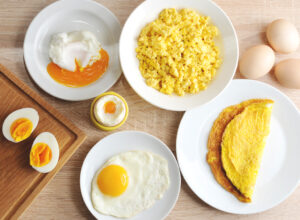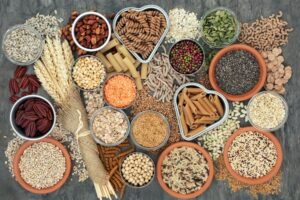Foods for the Heart
Heart-Healthy Ingredient Substitutions
Whether you’re recovering from a heart attack or trying to prevent one, a healthy diet should be part of the plan.
As you start building your healthy eating strategy, it’s important to know which foods to limit and which foods to target. Eating a balanced, nutrient-dense diet that includes fibrous carbohydrates, lean proteins, and healthy fats is key.
The American Heart Association (AHA) recommends limiting saturated fat to 5 to 6 percent of your total calories at most. For a 2,000-calorie diet, this is about 11 to 13 grams daily. They also recommend avoiding trans fats.
With a few simple swaps, you can help keep your ticker in top shape and still enjoy delicious food.
1. Mayonnaise
While you could exchange low-fat mayo for regular mayo, there are other delicious substitution options. One example is avocado, which when mashed can be substituted for mayonnaise in recipes like egg or potato salad.
Hummus is also a good option for making “salads,” like egg or tuna salad, or as a sandwich spread.
For green salads or mixing with vegetables, Greek yogurt is an excellent option. The tangy taste and smooth texture also make it great for adding to dips. Pesto is another flavorful option for veggies and potato salad instead of mayo.
Sliced-up hard-boiled eggs are also a great substitute for mayo on a sandwich. Because mayo has eggs as part of its base, there is a similar flavor and boosted protein but fewer calories and fat.
2. Cheese
Reduced-fat and low-fat cheese offers a great-tasting alternative to the full-fat versions. Although fat-free cheese may seem like the better option, most brands tend to be very gummy, don’t melt well, and have little taste. Low-fat cheese, though, has the same taste and melting qualities as the original but with significantly less fat.
3. Salt
Most doctors, along with the AHA, recommend a diet containing less than 2,300 milligrams of sodium per day — that’s less than 1 teaspoon. If you already have high blood pressure, aim for less than 1,500 milligrams per day.
Instead of salt, add a splash of vinegar or a squeeze of fresh lemon. Using herbs and spices is a great way to give a familiar dish a new twist. Try creating your own salt-free spice blends to have on hand when you need a flavor boost.
4. Eggs
Eggs are an excellent source of protein and essential nutrients, but they do contain saturated fat. One large egg contains 1.6 grams of saturated fat. Instead of cutting eggs out completely, try to consume them in moderation, which means seven or fewer whole eggs a week for a healthy individual.
Expert’s tip: Opt for making a “chia egg” for a fibrous, omega 3-rich egg replacement in baked goods. Mix 1 tablespoon of chia seeds with 3 tablespoons of water to replace one egg in a recipe.
5. Ground beef
When you’re craving a juicy burger or a thick slice of meatloaf, mix equal parts lean ground turkey breast and grass-fed, lean ground beef. The ground turkey adds moisture and makes cooked burgers less crumbly.
For recipes like chili, pasta sauce, or casseroles that call for ground beef, substitute ground turkey without noticing much of a difference.
Also, consider buying organic to increase nutrient quality and density. Organic meats often contain higher levels of omega-3.
6. Chocolate
Chocolate does have a place in heart-healthy diets, but you should forgo white chocolate and milk chocolate varieties. Eaten in moderate amounts, dark chocolate (70 percent cocoa or higher) may reduce blood pressure and LDL (bad cholesterol) levels, according to the International Journal of Molecular ScienceTrusted Source.
For baked goods like cookies and cakes, finely chop the dark chocolate to evenly spread it throughout the recipe and reduce the amount of sugar called for by one quarter or one half.
7. Sour cream
Get the same tangy flavor without all the fat by pureeing equal amounts of low-fat cottage cheese and nonfat yogurt in a blender and using it in place of the sour cream. In baking, you can substitute an equal amount of low-fat or nonfat yogurt in many recipes.
Or try plain non-fat Greek yogurt. It’s considerably thicker and creamier than regular yogurt because a lot of the whey has been strained. It’s great on tacos!
8. Steak
Steak often gets a bad rap as being unhealthy. However, there are a number of cuts that are great lean-meat substitutions. Your best bets are:
- eye of round
- sirloin tip side
- top round
- top sirloin
Portion size is key. According to the USDA, a 3.5-ounce serving of lean beef has 4.5 grams or less of saturated fat and less than 95 milligrams of cholesterol.
Taste tip: For a cut of beef with an intense, beefy flavor, ask your local butcher about dry-aged beef.
9. Whole grains
Diets rich in whole grains have been shown to reduce high blood pressure, high cholesterol levels, and the risk of strokes, according to the AHA. You can substitute up to half the amount of all-purpose flour with whole-wheat flour in almost all of your favorite baking recipes. For added texture, try using 1/4 cup of rolled oats in place of all-purpose flour.
Expert’s tip: Don’t like the flavor or texture of whole wheat? Look for 100 percent white whole-wheat flour. It’s milder in flavor, but still has all the nutrition.
10. Sugar
New heart-healthy guidelines from the AHA urge people to consume no more than 100 (for women) to 150 calories (for men) from added sugars — that don’t naturally occur in food — a day.
You can substitute stevia or erythritol for up to half of the sugar in most baked goods without any difference in texture or flavor. Limiting intake of refined and processed sugars is best though. Try using 100% natural fruit juices to sweeten sauces and beverages.
Expert’s tip: High quantities of sugar can be found in items like ketchup, salad dressings, and sauces, so read the labels carefully.












